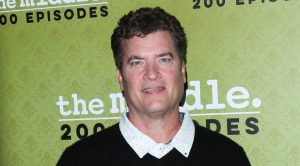Released on this day in 1980, some consider The Shining a cinematic masterpiece, a definitive example of supernatural and psychological horrors. To others (Stephen King included), the film failed to capture the tone and atmosphere of the original novel, making a mini-series adaptation feel necessary. Regardless of your thoughts on the film, there’s no denying the legacy it left on cinema and fans of horror everywhere.
The film chronicles the Torrance family as they’re tasked with maintaining the Overlook Hotel during the offseason, as its remote location in Colorado makes it virtually inaccessible due to snowfall. Shortly after their arrival, Jack Torrance begins to experience visions of a former caretaker of the facility, who had previously murdered his family in the hotel. As the days drag on, Jack descends into madness, eventually turning on his family in much the same way the previous caretaker had.
Videos by PopCulture.com
Prior to having filmed The Shining, Kubrick had made a wide variety of films, from erotic tales like Lolita to dark satires of politics like Dr. Strangelove and sci-fi epics like 2001: A Space Odyssey. The filmmaker spent the better part of a year attempting to bring the King novel to life, with some of the film’s most simple shots requiring dozens of takes to meet Kubrick’s strict standards.
Nearly 40 years later, the tale of the Torrance family, and its real-life inspirations, continues to thrill audiences around the world.
Scroll down to learn some of the most fascinating facts behind the masterpiece!
Tough Times On Set
Jack Nicholson’s performance as the head of the Torrance family is one of the defining roles of his career, but it wasn’t an easy thing for the actor to do. Actress Anjelica Huston, who lived with Nicholson at the time, claimed that the experience left him so exhausted every day that all he could manage to do was walk directly into the bedroom and immediately fall asleep.
Kubrick, ever the perfectionist, would provide the actors with rewrites so frequently that Nicholson stopped reading the script, anticipating all the changes he’d have to make to accommodate the updates.
Despite all of these difficulties, some of the moments Nicholson brought to the shoot ended up being some of the most memorable. One of these moments was Jack Torrance breaking down a door with an ax and exclaiming, “Heeeeere’s Johnny!” As he lived in England and wasn’t familiar with Johnny Carson, Kubrick didn’t understand the reference and nearly cut it. Another difficulty of this scene was that, with Nicholson having previously volunteered as a fire marshall, he quite easily demolished a prop door, forcing a real door to be used to be more believable.
The actor noted that the most difficult scene to shoot, however, was a scene in which Torrance snaps at his wife for interrupting his writing because he himself was a writer and he’d been in that situation with previous girlfriends, resonating a little too strongly with his personal life.

Tough Times On Set Pt. 2
By comparison to what Shelley Duvall withstood on set, Nicholson’s difficulties were a walk in the park.
In hopes of helping her achieve the mental state of a woman on her own trapped with a psychopath, Kubrick regularly antagonized Duvall and encouraged others to do so as well. The director went so far as to claim that she was responsible for wasting everyone’s time and was the reason for the film undergoing so many delays while also telling everyone on set to not sympathize with the actress.
Duvall reacted so severely to the harassment that she suffered panic attacks, exhaustion, and even lost her hair. At times, she cried so frequently that she would run out of tears, requiring her to constantly drink water to stay hydrated.
Once the ordeal was said and done, Kubrick spoke highly of her performance and was impressed with her abilities.

Blood Runs Red
Of all of the sequences in the film, the most time-consuming didn’t involve a single actor.
At one point in the film, an elevator door opens, spilling out a tidal wave of blood. Compared to other shots in the film, this one required the fewest amount of takes, totaling at just three. However, the complex shot took nine days to set up, resulting in it taking nearly a month to get the shot right for Kubrick, who often complained that it didn’t look like blood.
This shot was used in the film’s trailer, thanks to some trickery on Kubrick’s part. The MPAA doesn’t allow red blood to be shown in movie trailers, and the entire shot consists of flowing blood. Kubrick lied to the MPAA and told them that it wasn’t blood, but merely rusty water, which was entirely possible without context.
[H/T YouTube, MovieCriticBlog]
Lost In A Winter Wonderland
The shot of blood pouring out of an elevator might have been the most difficult shot in the film, but the final sequences were no walk in the park.
The film concludes with Danny Torrance entering a hedge maze next to the hotel and uses snow footprints to throw his dad off course before following his footsteps out of the maze. In reality, this sequence was shot on a soundstage with no air conditioners, causing the lights to make the set incredibly hot. Rather than snow, salt and crushed styrofoam gave the appearance of precipitation.
In the original story, the film ended with hedge animals coming alive, but Kubrick didn’t believe this would look believable, opting for the maze. Although the maze wasn’t as big as it appears in the film, it was still complex enough that maps were drawn for crew members to find their way around, taking over a month to complete the sequence.
[H/T YouTube, MarkBrownrigg]
Alternate Ending
One of the integral components of the original novel is that Jack needs to regularly vent the pressure from the boiler as to prevent a catastrophic event. Ultimately, his attacks on his family distract him from his duties, resulting in the boiler exploding. Knowing this would be too expensive, Kubrick went with the hedge maze ending instead, but even this wasn’t his original choice.
In Kubrick’s original script, Wendy takes a much more active role in Jack’s demise, stabbing him fatally in the stomach during one of their altercations. When Dick Halloran, a hotel employee shows up, he succumbs to the mental pressures of one of the hotel’s spectres, attempting to harm Wendy and Danny. When Dick confronts Danny, the young boy uses his mental abilities to slow down his attacker, allowing Wendy to kill him.
Additionally, the first week of the film’s release, a different ending was used. The extended ending takes place after Wendy and Danny escape, with the hotel owner coming up to the two of them in the hospital to tell them Jack’s body wasn’t recovered. He then hands Danny a ball that mysteriously rolled down the hallway earlier in the film.

The Creator Hated This Creation
Kubrick’s film might have a legacy in the world of cinema, but critics initially panned it, with one of its biggest critics being Stephen King. The author might have been impressed with the stunning visuals Kubrick achieved, he thought the film was missing heart, referring to it as a “Cadillac without an engine.”
In the original novel, Jack Torrance is painted as a sympathetic character who hoped to be a good father, despite his troubled past. King thought this was completely missing from the final film, as Nicholson had an intense demanor right from the film’s opening scenes. He has reportedly said of the film, “I think he set out to make a film that hurts people”.
Considering his personal connection to the story, King was highly invested in the finished product.
King’s inspiration came from a visit to the Stanley Hotel in Estes Park, CO, when he and his family were the last guests for the season. The whole hotel was notorious for being haunted, and when he saw a group of nuns checking out, it established the concept that the location had been completely abandoned by God.
[H/T YouTube, KnightKobra49]
Room 237 Conspiracy
When King stayed at the Stanley Hotel, he was a guest of room 217. In the novel, Danny ventures to room 217 to discover a woman’s corpse. The hotel owners requested Kubrick change the hotel room to 237, as the actual hotel didn’t have a room 237, so guests wouldn’t seek out/be dismayed by the “real” room in which the events occurred.
In the documentary Room 237, filmmakers explore a wide variety of conspiracy theories that fans of The Shining have developed over the years, ranging in various levels of plausibility.
Of these theories, one suggests that Kubrick has crafted an “impossible” hotel, which means the layout of isolated scenes and sequences creates a geography that couldn’t technically exist. Another theory is that, due to the specific placement of Calumet Backing Power is a clue from Kubrick that the film is an allegory for Native American genocide.
One of the more bold theories is that, due to Danny Torrance wearing an Apollo 11 sweatshirt in the film, it’s a hint that Kubrick filmed a fake moon landing for NASA and that humans have never actually set foot on the moon.
[H/T YouTube, Movieclips Trailers]
MORE NEWS:
- Stanley Kubrick’s ‘The Shining’ To Debut At Halloween Horror Nights
- ‘The Dark Tower’ Trailer Features ‘The Shining’ and ‘It’ References
- The Shining Deleted Scenes Help Explain That Mystery Ending
Photo Credit: Warner Brothers / Everett Collection







